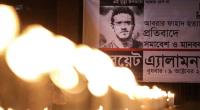 Nearly three-fourths of water-bodies and more than two-thirds of open space disappeared from capital Dhaka in a 20-year-span, starting from 1999, suggests a study of Bangladesh Institute of Planners (BIP).
Nearly three-fourths of water-bodies and more than two-thirds of open space disappeared from capital Dhaka in a 20-year-span, starting from 1999, suggests a study of Bangladesh Institute of Planners (BIP).
Conducting the survey on a 134 square kilometre (sqkm) area covering the undivided Dhaka City Corporation, BIP found that the city had 19.09 sqkm of water-bodies 20 years ago, but the amount has declined to 5.87 sqkm.
In 1999, the undivided Dhaka, which has been split into two since late 2011, had only 87.09 sqkm of concrete-covered area.
Open space used to cover 18.85 sqkm land in 1999, and the volume has significantly dropped to 6.17 sqkm as of December last year, BIP said, adding areas that underwent development projects expanded to 109.63 sqkm in the last two decades.
The study, however, says that some 8.97 sqkm areas of the city was covered with greenery back in 1999, and the number jumped by more than one-third to 12.33 sqkm over the past two decades.
Dhaka North City Corporation and Dhaka South City Corporation together now cover some 300 sqkm area, including their extended parts, following the 2011 division.
BIP General Secretary Adil Mohammed Khan disclosed the findings from their study, titled “Changes to Dhaka’s water-bodies, greeneries, concrete-covered areas and open spaces in the last 10 years,” at the BIP office in Dhaka on Saturday (Jan 4).
BIP also placed a 10-point charter of recommendations, including development of area-wise greenery, urban afforestation, recovering occupied or filled-up water-bodies and curbing construction in highly populated areas.
Adil said the expansion of greenery was still not satisfactory since it mostly surfaced due to unplanned construction projects.
Terming environmental management crucial for habitability in a city, Adil said that mindless urbanization, coupled with rampant grabbing of water-bodies and open spaces, has left Dhaka city highly vulnerable.
laming the government for worsening situation, he alleged: “I think the authorities concerned are not truly worried about the poor living conditions in the capital.”
“They are just verbally cordial to make the city liveable and addressing its major problems,” he said, adding that if the government does not consider the need for sufficient open space and water-bodies as public infrastructure, no changes will come. Dhaka shouldn’t be treated like a shop
Dhaka shouldn’t be treated like a shop
Mentioning the skyrocketing population of the already packed city, Adil said: “We forgot the need of more open space in proportion to the growing number of people in Dhaka.”
An effective long-term plan and political commitment can help overcome the issues that Dhaka has been facing, he said. “Politics is stronger than plans in countries like Bangladesh.”
Addressing Saturday's event, BIP President Akter Mahmud also said that proper development of a city depended on sufficient public space, transport and utility, all of which are lacking in Dhaka.
“Dhaka is becoming immensely non-liveable because we are treating it as a shop, not a city. People from across the country are coming here in major numbers for academic, political, medical and economic purposes,” he said.
The frequency of people has made Dhaka exceed its maximum carrying capacity, leading to its current poor state, he opined, demanding the city’s immediate decentralization.
Akter suggested that the government take immediate measures to save other major cities from becoming as exhaustive as Dhaka.
He also urged politicians to take seriously the issue of liveability in Dhaka in the upcoming city corporation elections and work accordingly.
AKM Abul Kalam, former president of BIP, said: “We had a flawed understanding about Dhaka’s future, leading to its misery. Even our way of implementing the relevant laws to protect the city was faulty.”
He suggested local government bodies to play bolder roles for urban development, so that no other cities in Bangladesh become like Dhaka.


